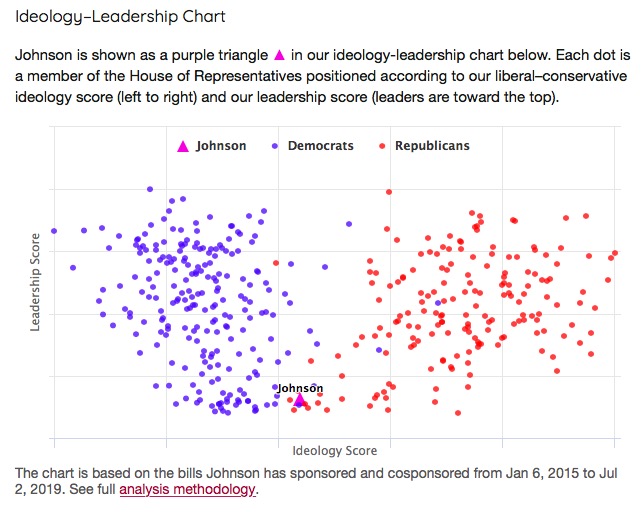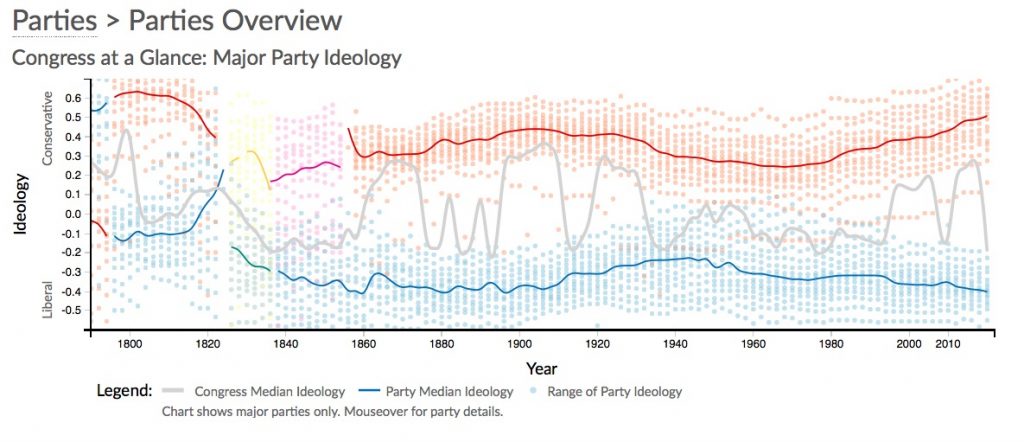
Jeepers: if Mike Rounds thinks Trumpist Scyller Borglum is a Democratic infiltrator, what must he think of his Washington colleague Dusty Johnson, who apparently has spent his first six months in Congress Representing like a centrist Democrat?
In 2019, the middle is a lonely spot in national politics.
However, according to GovTrack, an independent political and data research firm, that’s where first-term Republican Congressman Dusty Johnson finds himself.
As he’s only been in office since January, there are not as many data points on his record as there would be for longer-tenured members. So its possible his position could change as he sponsors or co-sponsors more legislation.
Still, in the time he’s been there, he’s in the middle along with a few Democrats [Todd Epp, “Dusty Is Nearly Alone in the Middle in Congress,” KELO Radio, 2019.07.05].

GovTrack generates the above map of “ideology” by a purely mathematical interpretation of bill sponsorship. They don’t do any textual analysis to determine whether any of Dusty’s eight bills so far are “conservative” or “liberal”; they just create a matrix showing how often Congressperson Y co-sponsored a bill introduced by Congressperson X, then plot Congresspeople left and right along the ideology axis based simply on how often or how rarely they appear on bills with each other. At the extremes, the farthest left blue dot (Rep. Barbara Lee of California’s 13th, based in Oakland) and the farthest right red dot (Rep. Paul Gosar of Arizona’s 4th, a gerrymander slopped across the western and central part of the state) have the least intersection of bill sponsorship.
Under that math, likely exerting the most central pull on Congressman Johnson’s score is his H.R. 3183, the Feed Emergency Enhancement During Disasters Act, which would allow farmers to collect indemnity payments for prevented planting of their first intended crop even if they manage to plant and usably harvest a second crop on the same land. If we were looking purely at text, we’d say, “Dishing out more government money to people in distress? That’s a liberal leftist bill!” But GovTrack ignores content and looks at sponsors, and H.R. 3183 has 32 mostly Farm-Belt co-sponsors, 10 of whom are Democrats.
Congressman Johnson also has one Democratic co-sponsor (out of two) on H.R. 3132. His H.R. 1732, to build Trump’s wall in disregard of the National Environmental Policy Act and the Endangered Species Act, has four Republican co-sponsors. Dusty stands alone on his other five bills.
Bill sponsorship patterns may put Congressman Johnson in the middle, but analysis based on votes puts Dusty in the middle of the Republican right:

The UCLA Department of Political Science’s Vote View project says our lone Representative’s votes indicate he is more conservative than 75% of his House colleagues but more liberal than 54% of his Republican House colleagues.
Remember that being in the middle of the 2019 GOP still makes Dusty a pretty hard conservative by recent historical standards. Since Dusty was born in 1976, Vote View finds that his Republican Party has shown a far stronger shift to the right than the Democratic Party has exhibited to the left.

Since the 95th Congress of 1977, GOP Congresspeople have shifted from a conservative median score of 0.26 to 0.51. Congressional Democrats over the same period, measured on the same scale, have shifted from –0.33 to -0.40. Landing near the middle of the 2019 median for Republicans, Rep. Johnson is markedly more conservative than a middle-of-the-pack Republican would have been forty years ago. For instance, Johnson’s ideology score is a 0.48. In 1977, Jim Abdnor‘s ideology score was 0.241. But even at that much more central score, Abdnor was still more conservative than 80% of all other House members and more liberal than 58% of his House Republican colleagues. Larry Pressler leaned conservative by 0.213, more conservative than 77% of the House but more liberal than 67% of the House GOP.
Dusty Johnson scores closer on Vote View’s scale to the Johnson who preceded him in the House 100 years ago, Royal Cleaves Johnson, who represented our Second District (northeast) from 1915 to 1933. Fifty Congresses ago, Royal C. scored 0.389 on the Vote View ideology meter. Among a similarly polarized, anti-Wilson House, Royal C. was more conservative than 68% of the body and more liberal than 57% of his party colleagues.
One more comparison: on GovTrack’s sponsorship scale, Michigan’s party-bolter Justin Amash is in the middle quintile, just a snudge right of our man Dusty. But Vote View puts newly independent Amash to the right of 93% of the House and to the right of Johnson and 85% of the House GOP. More clearly distinguishing Amash from Johnson is party loyalty: Johnson votes with his party bosses 96% of the time, while in this Congress, Amash voted with Republicans only 63% of the time. The median House Republican votes the party line 90% of the time.
Republicans, beneath Trump, have nearly abandoned the center. We’ll take it. Heck, we’ve always lived there and only moved a bit left to avoid association with the current White House. Social Security is centrist. So is Medicare, Medicaid, Obamacare, Veterans Administration, clean energy, PBS, CDC, and transportation. We’re about to elect a centrist president and a centrist congress.
You’re welcome to join us, conservatives.